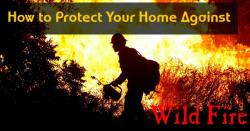Forest fires consume some 8 million acres in the U.S. each year, according to insurance industry sources, with most major fires occurring in western states. The most recent example of the devastation that such fires can cause is of course the wildfires that swept through the Napa Valley in California in October.
 If your home is in an at-risk area, take these steps to increase the chances of it surviving a wildfire with minimal damage.
If your home is in an at-risk area, take these steps to increase the chances of it surviving a wildfire with minimal damage.
Prepare ‘defensible space’
“Defensible space” is essentially the last-ditch firebreak immediately around your home. Many fire prevention concepts are organized around the concept of maximizing defensible space.
Essentially, this means maintaining at least 30 feet of space around your home that is free of potential fuel that flying embers may ignite. You should:
• Mow the grass. High grass is a pathway for flames that will lead right to your home.
• Eliminate shrubs within 5-10 feet of your home.
• Rake pine needles and dry leaves away from your home.
• Don’t plant shrubs near windows or vents.
• Install a non-flammable ground cover immediately around the structure.
• Prune overhanging branches.
• Trim the lower branches off trees for at least 100 feet from your home.
• Keep propane tanks at least 30 to 50 feet away from your home.
For more detailed information about creating a defensible space around your home, read the Colorado State Forest Service guide, “Protecting Your Home from Wildfire – Creating Wildfire Defensible Zones.” The guide is available here: https://csfs.colostate.edu/wildfire-mitigation/protect-your-home-property-forest-from-wildfire/
Fireproof your home
• When you re-roof, ensure you install Class A-rated materials. This includes both the roof exterior and underlying materials.
• Avoid wooden roofs, or treat them with a Class A fire-retardant roof coating.
• Enroll in your insurance carrier’s Wildfire Response Program, if one is available in your area. Some insurance carriers contract with fire response teams who go into neighborhoods threatened by wildfires and help with final preparations, apply fire retardant coatings and sprays, and advise residents and customers.
• Install non-flammable siding.
• Install mesh screens of 1/8” or less in vents and chimneys to block flaming embers.
• Remove leaves and other debris from gutters and roofs. Install a gutter cover to keep them free of leaves, and to block flaming embers from igniting any debris in your gutters.
• If your home is on stilts, screen or wall off the underside of the property.
• Replace single-pane windows with dual-pane windows.
• Use tempered glass in all windows.
• Keep firewood at least 30 feet from your home.
Decks and lanais
• Use non-flammable materials for new deck construction.
• Screen in deck areas to repel flying embers.
• Treat wooden decks with a Class A fire-retardant coating.
• Clear the underside of decks of all debris. Don’t store anything flammable under the deck.
For more detailed information on fireproofing your home, including information on design and building materials, download the Colorado State Forest Service guide, “FireWise Construction: Site Design and Building Materials.” The guide is available here: https://static.colostate.edu/client-files/csfs/pdfs/firewise-construction2012.pdf
Above all, keep yourself and your family safe. Don’t try to be a hero and fight a wildfire by yourself with a hose. Do what you can, well before the fire, and know when to leave.
If your home is damaged, don’t re-enter until you have been cleared by fire officials to do so.
